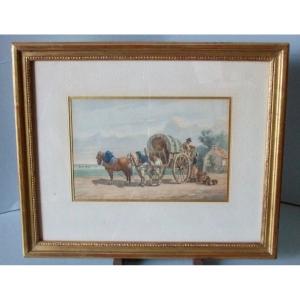This original watercolor on graphite lines is monogrammed at the bottom right: LV
It is referenced in the Louis Valtat Archives under number 2347/Ag
A certificate from the Friends of Louis Valtat association accompanies this work.
Presented under glass and in a beautiful carved wooden frame, including frame dimensions: 48 x 40 centimeters.
Biography:
Born in Dieppe on August 8, 1869, Louis Valtat studied humanities at the Lycée Hoche in Versailles where his parents settled. In 1886, aged 17, Valtat applied for admission to the École des Beaux Arts, and completed his training at the Académie Julian where he became friends with Albert André and Pierre Bonnard. Winner of the Jauvin d'Attainville prize in 1890, he set up his workshop on rue de La Glacière in Paris, and the paintings of his first submission to the Salon des Artistes Indépendants of 1893 had as their motives the animation of the surrounding streets, like the painting, On the boulevard, which will be noticed by Félix Fénéon. At the end of 1894, in collaboration with Henri de Toulouse Lautrec, helped by Albert André, he created a set for the theater of “l'Oeuvre” at the request of Lugné Poë. At the end of the year, his engravings and paintings appear on the walls of the Salon des Cent. But suffering from phthisis, he left for treatment stays in Banyuls where George-Daniel de Monfreid introduced him to Aristide Maillol, he made several escapades to Spain, to Llança or Figueras. In 1895, continuing his convalescence in Arcachon, Louis Valtat produced numerous paintings in very violent tones which, exhibited at the Salon des Indépendants in 1896, were noticed by Félix Fénéon who mentioned them in the Revue Blanche; these paintings announced "Fauvism" which caused a scandal 10 years later at the Salon d'Automne of 1905. At the group exhibition organized by Paul Signac at the Galerie Durand Ruel, in March 1899, he appeared with twenty paintings, fifteen of which were grouped under the title “Notations d’Agay, 1899”. Indeed, since the winter of 1887-1898 it is in Agay, a small fishing hamlet near Saint Raphaël, then in Anthéor a few kilometers away, that Louis Valtat has resided from autumn to spring, with his wife Suzanne. He married in March 1900. It was also in 1900 that, on the friendly advice of Renoir, Ambroise Vollard entered into an agreement with Valtat, of which he acquired practically the entire production for more than ten years. During their stays in Anthéor, the Valtats often crossed the Estérel, sometimes by bicycle, to go see Auguste Renoir who at that time rented the “Maison de la Poste” in Cagnes. On the occasion of one of these visits in 1903, Renoir painted the Portrait of Suzanne Valtat, while Louis Valtat created several portraits of Renoir in ink, drawings which he used to engrave a woodblock. The distance separating Anthéor from Saint Tropez being approximately 40 kilometers, visits to Paul Signac are easily made during the day aboard the Bollée, an oil cart that Valtat got from Signac in exchange for his painting “Le Cap Roux”. His distance from Paris did not prevent him from being present in Brussels in 1900 at the La Libre Esthétique exhibition with Le jardin du Luxembourg and Le boulevard Saint Michel; just as he was later in Vienna in 1903 at the “Gebaüde der Secession”, in Dresden in 1906 at the Kunst Salon Ersnt Arnold and in Berlin at the Berliner Secession, as well as in Budapest, Prague, and Moscow in 1908 at the Moskva Tretyakov Gallery. The Russian collector Ivan Morossov bought several paintings by Valtat from Vollard. As Vollard owns practically the entirety of Valtat's production, it is generally the dealer who is responsible for sending these paintings to the main avant-garde exhibitions. It is also Ambroise Vollard who sends the paintings for the exhibitions held in Paris; thus Louis Valtat participated in the “Fauvism” scandal at the Salon d'Automne of 1905 because one of his paintings was reproduced in the newspaper “L'Illustration” alongside those of Henri Manguin, Henri Matisse, André Derain and Jean Puy . In spring and summer, to find the seaside and above all to be able to paint there, Louis Valtat willingly went to Normandy, to Port en Bessin, to Arromanches and later to Ouistreham. When he was not in Anthéor or in Normandy, leaving his parental home in Versailles, the Valtat household settled in 1905 on the Butte Montmartre, successively rue Girardon and place Constantin Pecqueur. In 1914 he moved to avenue de Wagram, near the Arc de Triomphe and the Bois de Boulogne, whose lakes are a recurring subject in Valtat's work. After putting an end to his stays in Anthéor in 1914 and having spent ten years without the pleasures of a garden, Louis Valtat acquired a property in Choisel, a small village in the Chevreuse Valley where he happily stayed in 1924. a large part of the year. His garden, like the flowers and fruits he grew there, were the favorite motifs of his paintings. In Choisel Valtat likes to receive his friends, Georges d'Espagnat, or Maximilien Luce who will take advantage of one of his visits to paint a painting of the village church. Now official recognition has been acquired for him: he is named knight of the Legion of Honor in 1927; for the Fauvism exhibition presented in the summer of 1951 at the National Museum of Modern Art in Paris, he was present with six paintings including No. 116 “Trees” which since then seems to have followed a very strange path! After the exodus of 1940 and the years of occupation, Louis Valtat, suffering from glaucoma, hardly left his studio on Avenue de Wagram where he created his last paintings, which he dates from 1948.

























 Le Magazine de PROANTIC
Le Magazine de PROANTIC TRÉSORS Magazine
TRÉSORS Magazine Rivista Artiquariato
Rivista Artiquariato
